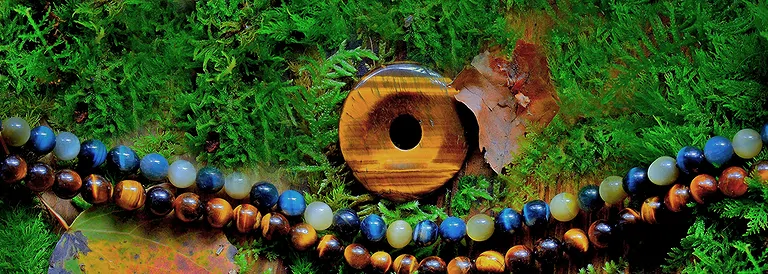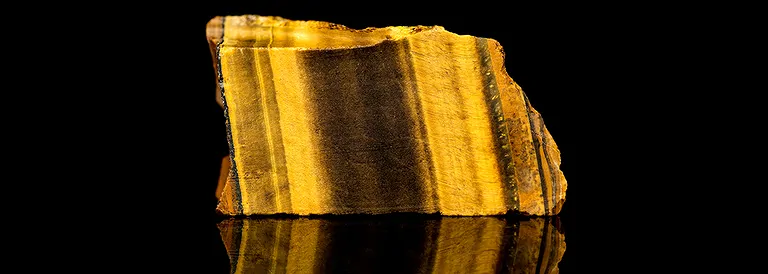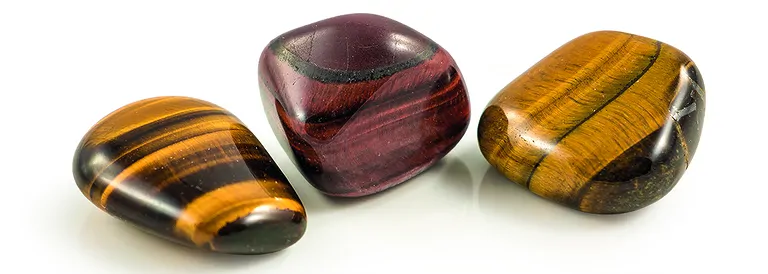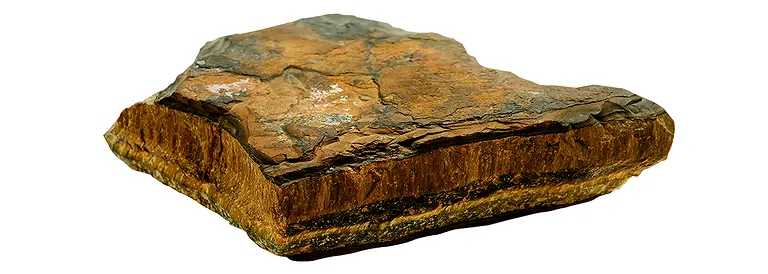
Tiger's Eye - Bearing, effect and application of the popular gemstone
Golden Tiger's Eye can help bring light into the dark. With the necessary distance to the lively times, we can devote ourselves in this phase to the analysis of complex systems and complicated situations dedicate. The stone sharpens the senses, facilitates the perspective and supports to make the right decisions. In a present full of challenges, the dazzling Tiger's Eye conveys confidence and the hope on a future, in which everything becomes easier.
Mineralogical profile of Tiger's Eye
Chemical Formula: SiO2 + FeOOH + (Al,Mg,Na), mineral of the quartz group from the mineral class of oxides
Formation: Secondary hydrothermal as silicified gangue fillings of metamorphic crocidolites. Initially, Falcon's Eye, closely related to Tiger's Eye, is formed, which later transforms into Tiger's Eye by oxidation
Color: golden yellow to golden brown, with light reflections caused by fibrous inclusions, reminiscent of Tiger's Eye. For more see "Treated Tiger's Eye"
Transparency, luster: opaque, silky luster
Crystal system: trigonal
Mohs hardness: 7
Cleavability, fracture: none; fibrous
Appearance: Tiger's Eye does not form crystals, but is found as a coarse quartz vein with a fibrous structure in the rock.
Localties: The most important Tiger's Eye deposits are in South Africa and northwestern Australia. The Tiger's Eye items on the market are from South Africa. The occurrence there is very large in terms of area; however, the found quantities of rough stones are limited, because Tiger's Eye occurs only in thin layers, a few centimeters thick. Small occurrences of Tiger's Eye are also known from England, Montana (USA), and eastern Australia. A suspected occurrence is located in the San Carlos Reservation (Gila County, Arizona, USA).

Origin of the name Tiger's Eye and synonyms
The mineral Tiger's Eye got its name because of its fibrous structure, which - properly cut - has a glimmer of light reminiscent of a tiger's eye. The name "Tiger's Eye " came about in the mid-19th century to distinguish Tiger's Eye from Falcon's Eye. Both gemstones are also referred to as misleadingly as Cat's Eye Quartz or Quartz Cat's Eye, as well as Pseudo Crocidolite or Schiller Quartz. Other synonyms rarely used today are wolf's eye and tigerite. If the Tiger's Eye is characterized by a high quartz content and thus appears brighter, the mineral is also called Gold Quartz.

Historical uses of Tiger's Eye
The use of Tiger's Eye as an amulet goes back to the Middle Ages. It was worn against witches and demons and was supposed to protect against the evil eye. By association with the eye of a tiger, the stone was considered a lucky stone for eyesight. After the mineralogical classification of Tiger's Eye in 1883, the stone was initially cut exclusively in Idar-Oberstein.

Heated Tiger's Eye
Very popular is the firing of Tiger's Eye, i.e. heating donuts, chain strands or Tumbled Stones. This is possible at relatively low temperatures even in conventional ovens. By firing, Tiger's Eye acquires a strong copper-red color, which can play by subsequent cooling in spirit up to violet color shades in. Red Tiger's Eye is not found in nature, so it is always fired. When Tiger's Eye is boiled in acid, the stones become gray; these are then falsely sold as Cat's Eye Quartz. However, since both rough stones are now equally expensive, this laborious process is no longer used.

Cat's Eye and Tiger's Eye - Chatoyance!
The addition of "cat's eye" is used in mineralogy and gemology to describe gemstones that have an areal, iridescent play of light. Thus, it is not a specific mineral, but an effect that can occur with various gemstones can occur. To show this effect as well as possible, the corresponding stones are often cut as cabochons or spheres. Then a bright light stripe appears, which appears with movement perpendicularly to the fibers of the gemstone. appears. This effect is called cat's eye effect or chatoyance.
The origin of the term "chatoyance" is not definitively clear - possibly the word derives from the French "chat" (cat), as the bright streak of light on the cut stone is reminiscent of the slit eyes of cats. Another approach starts from the word origin "chatoyer", the French word for shimmer.
The optical phenomenon of the cat's eye effect arises from numerous fine parallel fibers (e.g., rutile fibers in Chrysoberyl) or channels in the gemstone that reflect incident light perpendicular to their axis. In retail and wholesale trade, "cat's eye" is usually used to refer to Chrysoberyl. However, this effect is also possible with many other stones besides Tiger's Eye and Falcon's Eye, e.g. Apatite, Chromium Diopside, Ruby (Star Ruby), Sapphire (Star Sapphire) and tourmaline. In mineralogy, Cat's Eye Quartz is a white quartz that shows a cat's eye effect due to ingrown, parallel amiant (Hornblende asbestos). Foreign substances color the quartz then yellow, brown or gray.

Applications of Tiger's Eye in gemstone healing and well-being
In modern stone healing, Tiger's Eye is used for decision-making difficulties. In unclear situations, it should help to find the perspective by creating distance to what has happened. It strengthens stamina and steadfastness in difficult phases of life. Tiger's Eye cheers up in despondency and depressed mood and supports the confidence that things will turn out well. Michael Gienger describes the stone aptly: "Just as a tiger sees in the dark, the Tiger's Eye also helps, always do the nearest thing and to solve one problem after another in the confidence of a good outcome."
In gemstone massages, Tiger's Eye is used rather rarely. A possible application is a treatment that allows to come to rest, if it goes under and over and many things happen at the same time. Tiger's Eye provides then the necessary distance to the impressions and energies rushing in from the outside and thus helps to (re)gain perspective, not to lose courage and to be completely in one's own self. In the massage, the combination with the gemstone oil "Anti Stress" from the gemstone balance concept of Monika Grundmann has proven itself. Tiger's Eye provides here the necessary time out to get back the perspective. With Aventurine, Smoky Quartz and Magnesite can then be relaxed and calmly worked on simple solutions.
Tiger's Eye should not be worn continuously as a therapy stone for more than a week, as it inhibits the flow of energy. For meditations in a stone circle, Tiger's Eye can be used indefinitely.
Tiger's Eye is associated with the first, root chakra and the third, solar plexus chakra. Astrologically, Tiger's Eye fits best with the signs Leo, Gemini and Virgo.
Wholesale prices for gift, presents, jewelry and much more tiger's eye items







